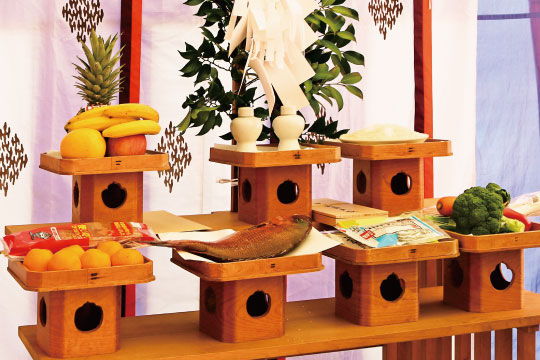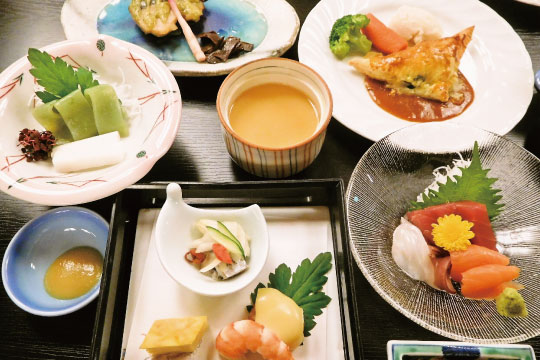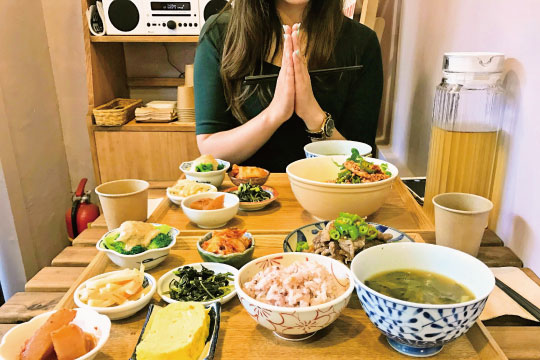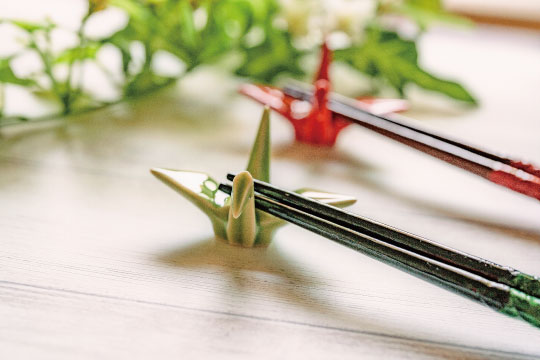News & Blogs
The origin of Japanese food: Offering meals to deities as a token of gratitude.
Prayers to express gratitude before and after meals
"Holy tweezers" evolved into chopsticks
In this blog, we touch on diverse topics about Japanese food cultures, practices together with the culinary secret, TREHA®, and its important role in the Japanese food industry. We hope our blog helps you obtain in-depth knowledge of Japanese cuisine and the science behind it, which is hard to find elsewhere.
The divine offering of gratitude is the origin of Japanese food.
The Japanese have lived with a variety of food resources through four distinct seasons, while occasionally encountering devastating natural disasters. The necessity to coexist with nature developed unique customs to respect and appreciate what nature presents to humans by discovering deities in nature to be praised in many aspects of daily life or at special ceremonies and festivals. This is the foundation of the "Shinto" religion.
Since it is an ingrained concept for the Japanese to consider every natural element as a deity, food offerings to deities are made throughout the seasons. The offering meals (shinsen 神饌) consist of traditional staple foods such as rice, mochi (rice cake), sake, salt, and water, along with the best catch and harvest available in the season from the mountains to the sea. Shinto priests conduct the purification ritual by washing their entire bodies prior to cooking the offering meals. The meals are deliberately prepared to display the height of respect and gratitude for the deity.

Such practices based on the Japanese temperament of respecting nature were registered with the UNESCO Intangible Cultural Heritage in December 2013 under the title of "Washoku (和食), traditional dietary cultures of the Japanese.”
Japanese cuisine is derived from Shinto and thus traditional. It seems that some people are hesitant with the traditional tone of Japanese cuisine for the fear of looking ignorant or even rude. No worries at all. Similar to Japanese religious views, Japanese cuisine features a good amount of flexibility and acceptance, which have been indispensable to live on the island with disaster-prone climates. We are very good at accepting new ideas and concepts while preserving old traditions. This must be why teriyaki burgers and mochi ice cream were created. Please feel free to explore.

"Itadaki-masu" and "Gochiso-sama": Short phrases to be chanted in unison with family members or guests before and after meals.
Since ancient times, the Japanese have respected nature through special ceremonies and seasonal festivals besides daily activities. In Shinto, it is believed that the food and beverages offered to the deity contains positive energy. Thus, sake and food offered to the deity are equally shared and consumed among all the participants to conclude the special events, with a wish to build a stronger connection with the deity to further flourish. In Japanese, there are two specific greetings used before and after a meal to express gratitude.
Before a meal: "Itadaki-masu (いただきます)"
It is believed that the word derived from a humble expression to "eat" or "receive" is based on a ritualistic gesture of elevating the consecrated items above the head (itadaki, meaning the top of the head). People often did so to show their respect right before consuming the offering to a deity or receiving something from a higher-ranked or elder person. Meanwhile, there is another belief that the phrase developed in order to express gratitude to the animals and plants who sacrificed their lives and to cooks who prepare such ingredients.
After a meal: "Gochiso-sama (ごちそうさま)"
The word is meant to express gratitude toward hospitality and food itself. The direct translation is "thank you for going afar", meaning "It was a feast." Though it is not a modern word, "chisou" means to run, go far, and work hard to collect ingredients, which is later referred to as a feast itself. The word is meant to express gratitude toward hospitality.
From the time of preschool, children in Japan are taught to join hands and say "Itadaki-masu" and "Gochiso-sama" in unison with classmates before and after meals. During younger ages, it is very common to eat the same meal with classmates excluding food allergy situations. Younger children become active and animated (too animated sometimes) from conversations with friends, but no matter how exciting lunchtime becomes, everyone is expected to greet before and after meals. Typically a child in charge of class duty of the day would stand in front of his/her classmates leading the greetings.

Chopsticks, the utensils for deities
The utensils for Japanese food are undoubtedly chopsticks, which are also related to Shinto belief. It is believed that chopsticks were introduced to Japan at the end of the Yayoi period (around the 3rd century AD) from China with a 3000-years history of using chopsticks. Back then, chopsticks were not exactly everyday utensils, but ritual tools accompanied by offering to deities including spirits of ancestors. Thus, the utensils are only for deities and the emperor as an arahitogami (現人神), meaning a deity as a human being. The divine utensils did not look like chopsticks of modern days, but tweezers made of bamboo.
Shinto shrine is also a place for tens of thousands of people to participate in special ceremonies for purification and supplication. After the ceremonies, the visitors often receive chopsticks as part of food offerings to obtain the positive energy of the deity.

Come to think of it, Japanese food culture is a collection of gratitude towards all featured casts: cooks who prepare meals with care for the guests, the guests who thank the cooks, and any life forms sacrificed their lives to be consumed as food. Let's put our palms together. "Itadaki-masu!"
Did you find this blog interesting?
Please share it with your friends in the food service industry.
We regularly update the blog about the food culture of Japan, where TREHA® was discovered for culinary applications.
Click here and send us a message to subscribe.
Or hit us up on Instagram @trehalose_sensei!
You might also be interested in the following blog articles:
Exclusive interview with Chef Meguro, the authentic Edomae sushi master in Tokyo
Exclusive interview with Chef Shimomura, the executive chef of a MICHELIN Plate Japanese cuisine restaurant in Yokohama
Dashi soup stock – the foundation of Japanese cuisine
B-class Gourmet, an undervalued variety of Japanese cuisine
Samurais like it hot!? A story of tempura
Japanese traditional New Year’s dishes, Osechi-ryori (おせち料理)
For the Japanese, “Nigiri” comes to mind when you say sushi

